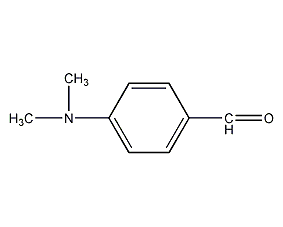
Structural formula
| Business number | 02H5 |
|---|---|
| Molecular formula | C9H11NO |
| Molecular weight | 149.19 |
| label |
p-dimethylaminobenzaldehyde, p-Dimethylaminobenzene aldehyde, p-dimethylaminobenzaldehyde, 4-N,N-dimethylaminobenzaldehyde, N,N-dimethyl-4-aminobenzaldehyde, p-(N,N-dimethyl)benzaldehyde, 4-Dimethylaminobenzaldehyde, p-dimethylaminobenzaldehyde, (CH3)2NC6H4CHO, 4-(Dimethylamino)-benzaldehyd, 4-Formyl-N,N-dimethylaniline, Benzaldehyde, p-(dimethylamino)-, Benzaldehyde,-(dimethylamino)-, Dimethylaminobenzenecarbonal, N,N-Dimethyl-4-formylaniline, P-(Dimethylamino)-benzaldehyd, p-(N,N-Dimethylamino)benzaldehyde |
Numbering system
CAS number:100-10-7
MDL number:MFCD00003381
EINECS number:202-819-0
RTECS number:CU5775000
BRN number:606802
PubChem number:24893588
Physical property data
1. Properties: off-white crystalline powder.
2. Density (g/mL, 20℃): 1.10
3. Relative vapor density (g/mL, air=1): Undetermined
4. Melting point (ºC): 72-75
5. Boiling point (ºC, normal pressure): Undetermined
6. Boiling point (ºC, 17mmHg): 176-177
7. Refractive index: 1.417
8. Flash point (ºC): 164
9. Specific rotation (º): Undetermined
10. Autoignition point or ignition temperature (ºC): Not determined
11. Vapor pressure (mmHg, ºC): Not determined
12. Saturated vapor pressure (kPa , ºC): Undetermined
13. Heat of combustion (KJ/mol): Undetermined
14. Critical temperature (ºC): Undetermined
15 . Critical pressure (KPa): Undetermined
16. Log value of oil-water (octanol/water) distribution coefficient: Undetermined
17. Explosion upper limit (%, V/V ): Undetermined
18. Lower explosion limit (%, V/V): Undetermined
19. Solubility: Slightly soluble in water, soluble in alcohol, ether, chloroform, Acids, most organic solvents.
Toxicological data
1. Acute toxicity: Rat oral LDLo: 500 mg/kg; Rat peritoneal cavity LD50: 620mg/kg; Mouse oral LD50: 800mg/kg; Mouse peritoneal cavity LD50: 200mg/kg; 2. Others Dose toxicity: rat peritoneal cavity TDLo: 1800mg/kg/9D-I;
Ecological data
This substance is slightly hazardous to water.
Molecular structure data
1. Molar refractive index: 47.31
2. Molar volume (cm3/mol): 139.0
3. Isotonic specific volume (90.2K ): 354.3
4. Surface tension (dyne/cm): 42.1
5. Dielectric constant:
6. Dipole moment (10-24cm3):
7. Polarizability: 18.75
Compute chemical data
1. Reference value for hydrophobic parameter calculation (XlogP): None
2. Number of hydrogen bond donors: 0
3. Number of hydrogen bond acceptors: 2
4. Number of rotatable chemical bonds: 2
5. Number of tautomers: none
6. Topological molecule polar surface area 20.3
7. Number of heavy atoms: 11
8. Surface charge: 0
9. Complexity: 126
10. Number of isotope atoms: 0
11. Determine the number of atomic stereocenters: 0
12. Uncertain number of atomic stereocenters: 0
13. Determine the number of chemical bond stereocenters: 0
14. Number of uncertain chemical bond stereocenters: 0
15. Number of covalent bond units: 1
Properties and stability
Avoid contact with air and light, and avoid contact with strong oxidants, strong alkali, and air.
Storage method
Store in a cool, ventilated warehouse. Keep away from fire and heat sources. The packaging must be sealed and must not come into contact with air. They should be stored separately from oxidants, alkalis, etc. and avoid mixed storage. Equipped with the appropriate variety and quantity of fire equipment. Suitable materials should be available in the storage area to contain spills.
Synthesis method
Using N,N-dimethylaniline as raw material, it can be produced by two methods. (1) Use methenamine to react to form methylene-N,N-dimethylaminobenzylamine, which is translocated to form N,N-dimethylbenzylamine, and then hydrolyzed to obtain the product. (2) React with dimethylformamide in the presence of phosphorus oxychloride. In addition, there is a laboratory preparation method that uses N,N-dimethylaniline, sodium nitrite, and formaldehyde as raw materials.
Purpose
It is used as a dye intermediate, as well as a reagent for the determination of urobilin, indole, alkaloids, etc. and a chromatographic analysis reagent.



 微信扫一扫打赏
微信扫一扫打赏
